
|

|

|
| From: Pascal SCHOENING : 22
MAY 1997 |

|
|
|
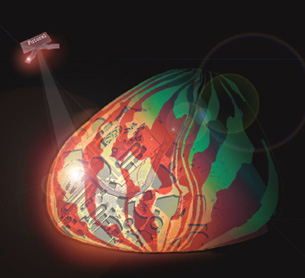 |
|
Plot #23 GMT±00:00 Pascal Schoning,
Ingerid Helsing Almaas and Associates with Asa Bruno and Eyal Weizman
et. al.(list to be extended as the project progresses)
FUTURE 2
‘Architecture has no existence but exists as the realisation of a
spirit'---Louis Kahn
Future 2 (future perfect), will+have+3rd form e.g “will have done”
An tense that expected completion of an event in the future. It conceives
of several time-layers simultaneously: future and past, memory and
expectation, prophesy and reflection, hopes and plans. Time with double
vision, forwards and backwards. The future points back in time and
is seen as an event completed, it could thus be reflected as memory
at present. Future and past oppose each another on the axis of time
by means of a paradigmatic temporal relationship. Future perfecto
is the memory of the future.
“The future will not easily reset further dematerialisation until
we reach a purer information Age, one in which the power of imagination
easily surpasses the world of matter.”----“Anywhere” conference, Japan
1992
Future perfect city incorporates all the world's time zones. Instead
of being located within the local time zone, the island Haishi is
itself divided into several separate time zones. Bands and pockets
of time emanate from an imagination assigned to Plot #23 and are superimposed
on the island, freeing it from the limitations of external temporality.
Each of these zones transgress natural time ,just as the island transgress
natural geography. This artificial time-zoning allows the co-existence
of contradictive modes of living and facilitates global engagement
at a time when media communication separates the location of being
from that of action. Plot #23 exists within the point of potential
that is GMT±00:00, which generates the time conditions for the rest
of the world and is defined as being without physical extension or
fixed location in any direction. It consists only of duration and
memory, and filters and projects consciousness.
As the local time and the corresponding activities will change from
one street to the next, one could go clubbing in one part of the island
(London time) and then go to the post office in another (Jamaican
time). While one part of the island sleeps (New York time), another
part will be open for business (Singapore time), and the island the
island are made visible on a large scale by colour-enhanced light,
crossing through both public and private spaces. Variable light intensities
within each zone will recreate the time-zone condition it relates
to: midnight to dawn, midday to dusk. Landing in the busy Hong-Kong
airport passengers looking down will see the island lit by different
bands, making it the worlds biggest painting. On a smaller scale the
intervention of light dissolves into another layer of detail which
engages the memories of each of the world time-zones it relates to,
by projection of images, film clips and texts. The projections play
against the growing urban fabric of the island, inviting a dialogue
with other participants' proposals, reaching both to their time-zone
location and to the form of their structure.
This urban intervention goes beyond the conventional physical nature
of urbanism. Time zones trace an invisible mark upon a territory,
whose limits are then designated by a great effect upon the life and
functions of the spaces they define. Our proposed time-zoning is an
adaptable in the city and the multitude of systems and memories it
embraces: culture, tradition, law, communication; economy and politics,
distinctness and hybridity. It's imposition and manipulation is therefore
a significant architectural act.
|
|

|
From: Pascal Schoening : 8
JULY 1997
|
|
FUTURE 2
CHRONOPOLIS / CHRONOGRAPHIS
"The loss of material space leads to the government of nothing
but time" (Paul Virilio)
Because Future2 has no size or location, it can have all sizes and
locations. Like the "future perfect" it exists simultaneously
in past, present and future, appears and disappears like the birth
and collapse of the universe. CHRONOGRAPHIS is the point of origin
of CHRONOPOLIS (Mirage City) covering the island in its entirety.
When it rests on Plot#23 it corresponds to the global coordinates
of Greenwich - the global time reference.
CHRONOGRAPHIS is a time-space demarcation, both a clock and a map
indicating the new "tempo spatiale" order of CHRONOPOLIS.
Within each hour the colour sequence of the light bands changes to
denote the lapse of time as well as the momentary placing of the bands.
Without size or location, devoid of defined materiality, CHRONOGRAPHIS
appears like a mirage to become a visual and spatial entity. It manifests
itself in the moment when time and space merge to create a simultaneous
and continuous entity, as the Future2-Piranesi satelite still hovers
above, following its memory-orbit and emitting its time-pulses.
|
|
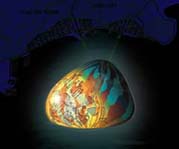
|
1. Future2-Haishi island - overview of the
island showing the time-zones |
|
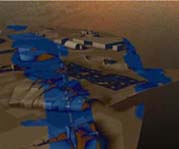
|
2. Future2-Kipnis - indicates how Kipnis'
and Eisenman's plots would be affected by the changing light conditions
which describe each time zone |
|
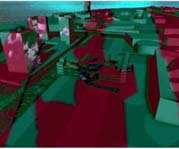
|
3. Future2-Perrault/Tschumi - indicates
how Perrault's and Tschumi's plots would be affected |
|
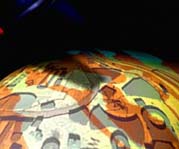
|
4. Future2-Piranesi Satelite - gives a view
of the island with the Future2 satelite hovering above |
|
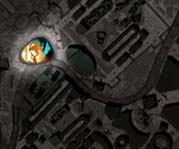
|
5. Future2-Plot#23 Chronographis - shows
our proposal for Plot#23, described in the text below |
|
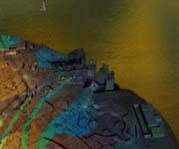
|
6. Future2-Portzampac - indicates how Portzampac's
plot would be affected |
|
| |
|
|
|
